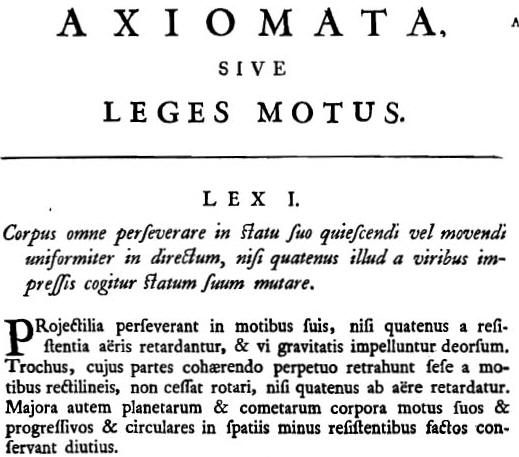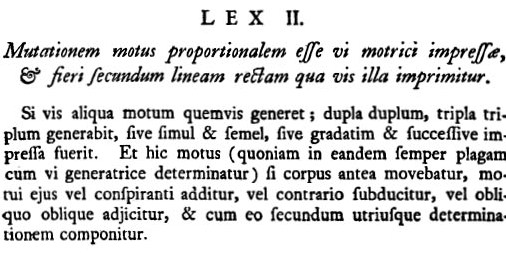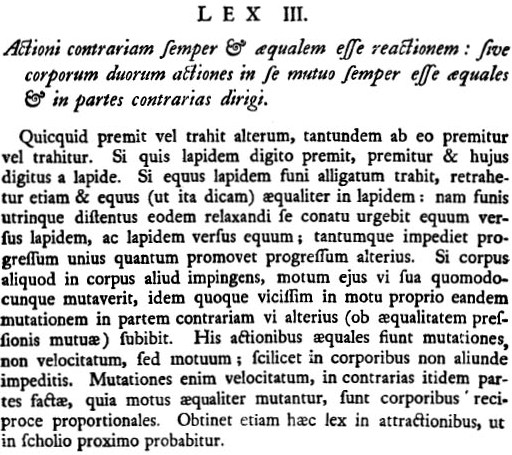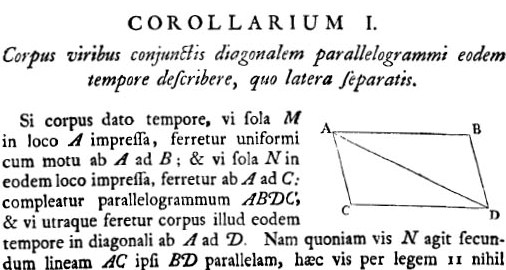Sir Isaac Newton
Philosophiae Naturalis Principia Mathematica
Definitiones
Axiomata sive Leges Motus (this page)
Characteristics of Newton’s Latin
Note: the laws are written in indirect statement.
Axiomata sive Leges Motus

Notes:
line 2 quatenus: to the extent that; by as much as; in as much as
lines 2-3 *a viribus impressis: ablative of means with preposition “a.”
(cf. “a resistentia aeris” below.) See Definitio IV for vis impressa.
line 5 deorsum: downwards
line 6 Trochus: a child’s toy hoop
line 7 recti-lin-eis: what part of speech? (-eus suffix)
line 8 majora: what does this modify?
lines 8-9 motūs . . . in spatiis minus resistentibus factos: motions . . .made in spaces that are less resisting/resistent, i.e. the vacuum of outer space
line 10 diutius: comparative of diū.

Notes:
line 1 motūs: genitive
vi motrici impressae: dative (with proportionalem)
*Note the adjective suffix: -tric- (“mot-ive”). cf. generatrice (“generative”) below.
line 2 qua: in the direction in which; where
line 3 *vis (aliqua): noun (not from the verb volo)
dupla [vis] duplum [motum]
line 4 sive . . . sive: whether . . . or
lines 4-5 impressa fuerit: tense? what would the classical Latin form be?
line 5 plagam: region, quarter, tract; direction
line 6 determino (1): fix, settle; bound; direct
line 7 conspiranti (dative): (breathing together); agreeing, combining, harmonizing; in the same direction

Notes:
line 4 tantun-dem: (just so much) by the same amount
line 6 funi < funis, -is, m.: rope
line 8 utrin-que: from both sides
line 8 eodem relaxandi se conatu
lines 8-9 versus: towards
lines 9-10 *tantum . . . quantum: . . . as much as
line 11 (motum) eius: i.e. of the other body
lines 11-12 quomodo-cunque: in some way; somehow
line 12 idem [corpus]: i.e. the first body
vicissim: in turn
line 14 sub-i-bit (sub-eo) undergo; suffer
line 15 non velocitatum, sed motuum: see Definitio II
aliund-e: otherwise
line 16 it-idem: likewise
line 17 factae: modifies mutationes
lines 17-18 reciproce: inversely
line 19 scholio: note


Notes:
lines 1-2 eodem tempore . . . quo: in the same time . . . as/in which
quo [corpus] latera [viribus] separatis [describere]
line 4 uniformi: what does this modify?
line 10 haec vis: force N
nihil: adverb
line 11 vi altera: force M
line 12 Accedet: note the tense.
Liber I: De Motu Corporum
Liber II: De Motu corporum
Liber III: De Mundi Systemate
Phaenomena